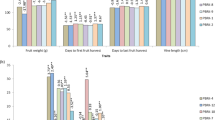Abstract
Gynoecious parthenocarpic hybrids in cucumber (Cucumis sativus L.) have great importance for its successful cultivation under protected conditions to enhance productivity and quality. Work was undertaken to develop and maintain the gynoecious inbred lines from the gynoecious parthenocarpic cucumber hybrids (Silyon hybrid, Pickling cucumber-1 (PC-1), Pickling cucumber-2 (PC-2) and Pune cucumber hybrid) at ICAR–Indian Institute of Horticultural Research, Bengaluru. Four slicing cucumber lines, namely IIHR-434, IIHR-435, IIHR-436 and IIHR-437, were raised to develop segregating populations. The individual plant selections were made in F2 population and through the pedigree method. These lines were forwarded to F4 generation based on the gynoecy sex expression, and mean performance of all four gynoecious lines was recorded. The F4 populations were validated at phenotypic as well as through SSR markers linked to gynoecious trait. The SSR-02021 and SSR-18718 genotypic data showed that, most of the plants are gynoecious in all four advance gynoecious lines. These inbred lines are further utilized to develop gynoecious parthenocarpic cucumber F1 hybrids.


Similar content being viewed by others
References
Agrawal R (1998) Breeding techniques in crops. In: Fundamental of plants breeding and hybrid seed production. Science Publishers, New Hampshire
Barnes WC (1961) Multiple disease resistant cucumbers. Proc Am Soc Hortic Sci 77:417–423
Barnes WC (1966) Development of disease resistant hybrid cucumbers. Proc Am Soc Hortic Sci 89:390–393
Beyer EM (1976) Silver ion: a potent anti-ethylene agent in cucumber and tomato. Hortic Sci 11:195–196
Bukovac MJ, Wittwer SH (1961) Gibberellin modification of flower sex expression in Cucumis sativus L. Adv Chem Ser 32:80–89
Byres RE, Baker LR, Sell HM, Herner RC, Dilley D (1972) Ethylene: a natural regulator of sex expression of Cucumis melo L. Proc Nat Acad Sci 69:717–720
Cantliffe DJ (1981) Alternation of sex expression in cucumber due to changes in temperature, light intensity and photoperiod. J Am Soc Hortic Sci 106(2):133–136
Chen XN, Cao P, Xu Q (1995) Genetic correlation and path coefficient analysis of parthenocarpic yield components of cucumber. Jiangsu J Agric Sci 3:32–35
De Candolle A (1882) Origine des plantescultive. Germes Bailliere, Paris, p 377
De Ponti, Kho YO (1977) Induction of male flowering in cucumber and gherkin by means of silver nitrate: an alternative to gibberelic acid. Zaadbelangen 31:53–57
Gaikwad AB, Saxena S, Behera TK, Archak S, Meshram SU (2014) Molecular marker to identify gynoecious lines in bitter gourd. Indian J Hortic 71(1):142–144
Gill HS, Singh JP, Pachauri DC (1973) Pusa Sanyog out yields other cucumbers. Indian J Hortic 18:11–30
Gopalakrishnan TR (2007) Cucumber. Vegetable crops. New India Publishing, New Delhi, pp 182–189
Hanchinamani CN, Patil MG, Dharmatti PR, Mokashi AN (2008) Studies on variability in cucumber (Cucumis sativus L.). Crop Res 36(3):273–276
Kalloo G (1988) Cucumber In: Vegetable breeding, vol I. CRC Press, Inc., Flordida
Kooistra E (1967) Femaleness in breeding glasshouse cucumbers. Euphytica 16:1–17
Krishnamoorthy HN (1975) Role of gibberellins in juvenility, flowering and sex expression. Gibberellins and plant growth. Wiley Eastern Limited, New Delhi, pp 115–143
Kumar S, Kuma RD, Kumar R, Thakur KS, Dogra BS (2013) Estimation of genetic variability and divergence for fruit yield and quality traits in cucumber (Cucumis sativus L.) in North-Western Himalays. Univ J Plant Sci 1(2):27–36
Lower RL, Edwards MD (1986) Cucumber breeding. In: Basset Mark J (ed) Breeding vegetable crops. AVI Publishing Company Inc, Westport, Connecticut, pp 173–207
Mohan Ram HY, Sett R (1982) Induction of fertile male flowers in genetically female Cannabis sativa plants by silver nitrate and silver thiosulphate anionic complex. Theor Appl Genet 62:369–375
More TA, Munger HM (1987) Effect of temperature and photoperiod on gynoecious sex expression in cucumber. Veg Sci 14(1):42–50
More TA, Seshadri VS (1988) Development of tropical gynoecious lines in cucumber. Cucurbit Genet Coop Rep 11:17–18
Munger HM (1979) A summary of cucumbers released from Cornell breeding program. Vegetable Improvement Newsletter Cornell Univ USA vol 24, pp 3–4
Munshi AD, Panda B, Behera TK, Kumar R, Bisht IS, Behera TK (2007) Genetic variability in Cucumis sativus var. hardwickii R. germplasm. Cucurbit Genet Coop Rep 30:5–10
NHB (2016) Indian horticulture data base. National horticulture board, Gurgaon, p 19
Panse VG, Sukhatme PV (1985) Statistical methods for agricultural workers. New Delhi, ICAR, p 695
Peterson CE, Andher LD (1960) Induction of staminate flower in gynoecious cucumber with GA3. Science 131:1673–1674
Prochazkova A (1986) Parthenocarpic fruit formation in foreign hybrids of pickling cucumber. Pl Breed 57(8):63–76
Sargent JA (1965) The penetration of growth regulators into leaves. Annu Rev Plant Physiol 16:1–12
Sharma A, Kaushik RA, Sarolia DK, Sharma RP (2010) Response to cultivars, plant geometry and methods of fertilizer application on parthenocarpic cucumber (Cucumis sativus L.) under zero energy polyhouse condition during rainy season. Veg Sci 37(2):184–186
Singh RK, Choudhury B (1989) Differential responses of three genera of cucurbits to boron and plant growth regulators. Indian J Hortic 46:215–221
Staub JE, Kupper RS (1985) Use of Cucumis sativus var. sativus. Hort Sci 20(3):436–438
Staub JE, Balgooyen B, Tolla GE (1986) Quality and yield of cucumber hybrids using gynoecious and bisexual parents. Hort Sci 4(3):510–512
Steele GD, Torrie JH (1969) Principles and procedures of statistics. McGraw Hill, New York, p 481
Win KT, Chunying Z, Kihwan S, Jeong HL, Sanghyeob L (2015) Development and characterization of a co-dominant molecular marker via sequence analysis of a genomic region containing the Female (F) locus in cucumber (Cucumis sativus L.). Mol Breed 35:229–238
Author information
Authors and Affiliations
Corresponding author
Additional information
Publisher's Note
Springer Nature remains neutral with regard to jurisdictional claims in published maps and institutional affiliations.
Rights and permissions
About this article
Cite this article
Bommesh, J.C., Pitchaimuthu, M., Ravishankar, K.V. et al. Development and Maintenance of Tropical Gynoecious Inbred Lines in Cucumber (Cucumis sativus) and Validation by DNA Markers. Agric Res 9, 161–168 (2020). https://doi.org/10.1007/s40003-019-00423-9
Received:
Accepted:
Published:
Issue Date:
DOI: https://doi.org/10.1007/s40003-019-00423-9




